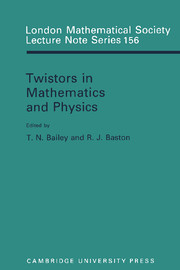Book contents
- Frontmatter
- Preface
- Contents
- 1 Twistor Theory After 25 Years—its Physical Status and Prospects
- 2 Between Integral Geometry and Twistors
- 3 Generalized Conformal Structures
- 4 Riemannian Twistor Spaces and Holonomy Groups
- 5 Twistors, Ambitwistors, and Conformal Gravity
- 6 The Penrose Transform
- 7 Notation for the Penrose Transform
- 8 The Twistor Transform
- 9 Invariant Operators
- 10 Penrose's Quasi-local Mass
- 11 The Sparling 3-form, Ashtekar Variables and Quasi-local Mass
- 12 Twistors and Strings
- 13 Integrable Systems in Twistor Theory
- 14 Twistor Characterization of Stationary Axisymmetric Solutions of Einstein's Equations
- 15 A Two-surface Encoding of Radiative Space-times
- 16 Twistors, Massless Fields and the Penrose Transform
- 17 Twistor Diagrams and Feynman Diagrams
- 18 Cohomology and Twistor Diagrams
- Authors' addresses
12 - Twistors and Strings
Published online by Cambridge University Press: 05 May 2013
- Frontmatter
- Preface
- Contents
- 1 Twistor Theory After 25 Years—its Physical Status and Prospects
- 2 Between Integral Geometry and Twistors
- 3 Generalized Conformal Structures
- 4 Riemannian Twistor Spaces and Holonomy Groups
- 5 Twistors, Ambitwistors, and Conformal Gravity
- 6 The Penrose Transform
- 7 Notation for the Penrose Transform
- 8 The Twistor Transform
- 9 Invariant Operators
- 10 Penrose's Quasi-local Mass
- 11 The Sparling 3-form, Ashtekar Variables and Quasi-local Mass
- 12 Twistors and Strings
- 13 Integrable Systems in Twistor Theory
- 14 Twistor Characterization of Stationary Axisymmetric Solutions of Einstein's Equations
- 15 A Two-surface Encoding of Radiative Space-times
- 16 Twistors, Massless Fields and the Penrose Transform
- 17 Twistor Diagrams and Feynman Diagrams
- 18 Cohomology and Twistor Diagrams
- Authors' addresses
Summary
A Complex Analytic Approach
Twistor theory has provided many valuable insights into the nature of space-time geometry and the processes that take place within that geometry. In particular, the very special role played by complex analytic functions has been elucidated in several contexts [36, 37, 38, 39, 41, 43]. A feature common to many twistor constructions is the solution of linear or non-linear differential equations by consideration of suitable analytic objects and the construction of machinery for transforming such objects into the desired solutions.
As noted in [40], this particular approach was in use many years before the formal development of twistor theory began. Weierstrass' 1866 construction [53] of solutions of Plateau's problem in three dimensions, for example, may be regarded as an important model for the twistor solution of non-linear problems such as the non-linear graviton [39]. The programme of work described here is founded on the notion that there is much that might be learnt by exploring constructions of the Weierstrass type, especially if insight can also be gained into string theory and its relationship to gravity. That twistor theory might provide some clues regarding this relationship has been suspected for some time (see e.g. [17]).
There are several sources of motivation for considering possible links between twistor theory and string theory. Hitchin [18] explained how the Weierstrass parametrization is essentially the understanding of how arbitrary holomorphic curves in the twistor space for three dimensions correspond to null holomorphic curves in complex three-space.
- Type
- Chapter
- Information
- Twistors in Mathematics and Physics , pp. 218 - 245Publisher: Cambridge University PressPrint publication year: 1990
- 2
- Cited by



